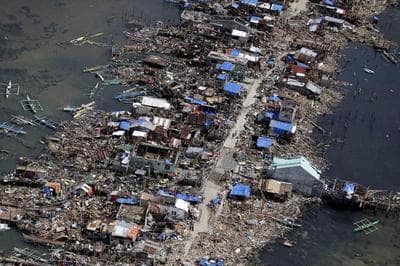Advertisement
Typhoon Haiyan And Rising Global Tides
ResumeWe go to the Philippines, to look at Typhoon relief efforts there, and the growing vulnerability of island nations.

It’s hard to watch the suffering in the Philippines after the onslaught of super typhoon Haiyan. Cities and towns just flattened. Now hungry, thirsty, sick, desperate. On a tsunami scale. Many have given for relief, but it’s hard for relief to get through, to get in. Airports too small. Roads blocked. Food convoys and warehouses attacked by hungry mobs and looters. And then, the terrible, hanging question: Is this the future? For Pacific islands? For coastal populations? For the global poor, and more? Up next On Point: responding, and reading the suffering, in the wake of Typhoon Haiyan.
-- Tom Ashbrook
Where To Donate
Guests
Ivan Watson, Senior international correspondent for CNN. (@IvanCNN)
Mike Delaney, director of humanitarian assistance at Oxfam. (@oxfamamerica)
Kerry Emanuel, professor of atmospheric science at the Massachusetts Institute of Technology.
From Tom's Reading List
TIME: Climate Change Didn’t Cause Supertyphoon Haiyan. But the Storm Is Still a Reason to Fight Warming — "U.N. Framework Convention on Climate Change head Christiana Figueres, who will help oversee the Warsaw talks, said the typhoon was part of the 'sobering reality' of global warming. The sheer power of Haiyan, as well as the still uncounted human devastation it has wrought, all but assures that the supertyphoon will become a symbol of climate change for years to come, just as Hurricane Katrina and Superstorm Sandy have. But how much of a role did current climate change actually play in the making of Haiyan? That’s less clear."
BBC News: Typhoon prompts 'fast' by Philippines climate delegate — "The head of the Philippines delegation at UN climate talks in Poland has said he will stop eating until participants make 'meaningful' progress. In an emotional speech, Yeb Sano linked the 'staggering' devastation caused by Typhoon Haiyan to a changing climate. Mr Sano said he was speaking on behalf of those who lost their lives in the storm and his fast would last until 'we stop this madness.'"
New York Times: Rising Despair as Officials Struggle to Get Aid to Victims -- "Philippine officials found themselves on the defensive Tuesday over the pace of relief efforts as Manila struggled to get supplies to the airport in the city of Tacloban, where as many as 10,000 people were feared dead and most of its residents were struggling to get basic foodstuffs and water four days after the typhoon struck on Friday."
This program aired on November 13, 2013.